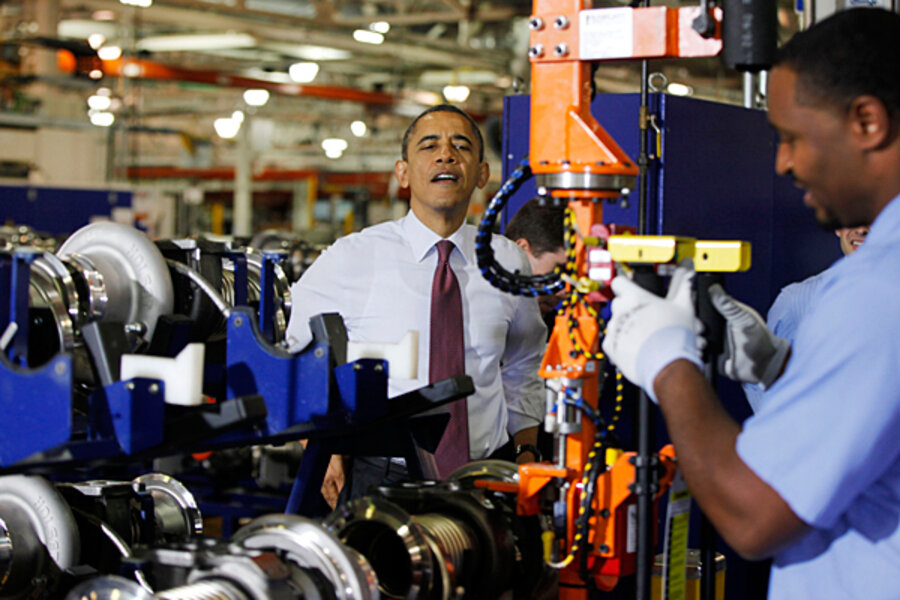Are moves to add jobs to US factory floors a harbinger, or outliers?
| Chicago
Recent days have produced a steady drip, drip, drip of good tidings about new jobs on America's factory floors.
Last week, Apple said it is investing $100 million to create new manufacturing jobs in the US, following similar announcements by fellow-electronics makers Hewlett-Packard and Levono Group and battery company LG Chem. On Monday, with President Obama in attendance, Detroit Diesel Corp., which makes heavy-duty diesel powertrains for the commercial truck market, said it would expand its line of transmissions and turbo chargers – investing $128 million and adding jobs to its Detroit-area plant.
“That means more work. That means more jobs and more products stamped with the stamp ‘Made in America,’ ” Mr. Obama said at the Detroit Diesel plant, which is owned by German conglomerate Daimler AG.
This is good news for the communities where the jobs are incoming, but economists caution that manufacturing is not likely to rebound to levels of 20 years ago – at least not anytime soon.
In remarks to Bloomberg News last week, Michael Marks, former CEO of Flextronics International Ltd., the second-largest electronics manufacturer in the world, said the Apple announcement represented “a trend that will start in little ways … and will pick up steam as suppliers move here. But this does not herald a booming return of high-volume manufacturing to the United States.”
Still, there are some encouraging signs. Since January 2010, the US has gained 496,000 manufacturing jobs, according to data from the US Bureau of Labor Statistics. That's fewer than one-quarter of the 2.3 million jobs the manufacturing sector lost during the Great Recession, which officially ended in June 2009. Manufacturing employment has remained relatively stable since last spring, according to a new BLS report, released Friday. While the food and chemical manufacturing sectors experienced losses, they were offset by job gains in motor vehicles and parts and wood products.
High fuel and energy costs worldwide, increased consumer and government scrutiny, the declining value of the US dollar relative to other currencies, and rising labor costs abroad are collectively making it more expensive for companies to outsource manufacturing, a point Obama emphasized at Detroit Diesel on Monday.
“When you factor in everything, it makes sense to invest right here, in America,” he said.
However, many labor economists and business leaders agree that the US factory jobs that vanished during the recession are not all likely to return, despite pockets of job gains by Apple and other companies.
Indeed, Apple’s move is expected to generate 200 jobs – a insignificant number compared with the tens of thousands of Chinese workers laboring to meet the high global demand of its bestselling products. Similarly, at Detroit Diesel, the $128 million investment that Obama is championing is expected to create about 115 new jobs.
Moreover, manufacturing jobs in the auto and truck sector are often unstable, says Willy Shih, a professor of management practice at Harvard Business School in Boston. Just as quickly as they are added, they can be eliminated if fuel prices in the US begin to approach those in Germany and other European countries, where fuel costs four or more times what it does in the US.
“Be careful, Mr. President, for what you take credit for. I’m not sure if that plant would have been cited elsewhere,” Mr. Shih says. “These are the types of jobs that if they come in [to the US], they can just as easily come back out.”
Even as anecdotal evidence suggests that manufacturing is rebounding on American shores, Federal Reserve data show otherwise, says Alan Tonelson, a research fellow at the US Business & Industry Educational Foundation in Washington. In October, manufacturing output, which represents 75 percent of total US production, fell 0.9 percent from the previous month. Mr. Tonelson writes on the foundation website that manufacturing output fell 1.49 percent between May and October, which provides “the first evidence that US manufacturing sector is now in recession.”
“These trends are strongly signaling that the reindustrialization needed to fuel a stronger and more sustainable economic recovery … will require much greater policy changes than so far proposed by either major [political] party. Reversing the vigorous rebound in the manufacturing-dominated U.S. trade deficit since the recovery began is the place to start,” he writes.
The number of such jobs may not return to the levels they were decades ago, but Shih says it is likely that the jobs destined to return are those that require advanced assembly room skills, as opposed to more rudimentary jobs associated mainly with low-skilled and low-wage workers found in assembly plants in China, Malaysia, Indonesia, and elsewhere.
For example, while Apple is adding about 200 manufacturing jobs, it previously announced a much larger addition to its job rolls – 3,600 new jobs – are expected to beef up its support staff in Austin, Texas, over the next decade.
“Jobs will come back in the form where workers will have to learn much more sophisticated processes or they’ll move to the next level up to use sophisticated machine tools,” Shih says.








